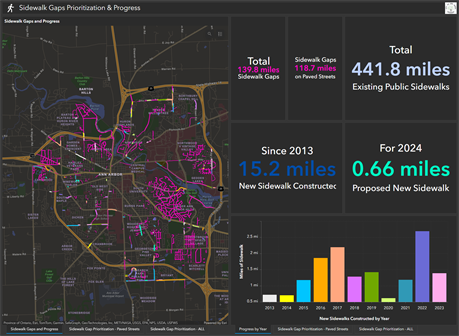Upcoming projects
2024
- 580 Burwood Avenue
- Glendale Circle & Fair Street
- Page Avenue (Harpst to Esch)
- Stone School Road (east side from Packard to Eisenhower)
- Sunnywood and Gralake intersection
2025
- Main Street (Stadium to Ann Arbor-Saline)
- Other neighborhood locations TBD
2026
- Apple Street (Pontiac to Pear)
- Barton Drive (M-14 to Brede)
- Brockman and Crestland (Packard to Ferdon)
- Dexter Avenue (Maple to Ironwood; one side TBD)
- John A Woods (Pontiac to Pear)
- Pear Street (John A Woods to Traver)
- Whitewood Street (Norwood to end of gap)
Sidewalk basics
The city has over 436 miles of existing sidewalks. By contrast there are approximately 144 miles of “gaps" in the city as define by locations in the public right-of-way adjacent to a street that do not currently have sidewalks. An online dashboard is available with information on sidewalk gaps. The magenta lines on the dashboard show all the places where there are currently no sidewalks.
Who pays for new sidewalks in Ann Arbor?
In November of 2020, voters approved a six-year New Sidewalk Millage, which will generate approximately $1.3 million per year, to be used exclusively for sidewalk gap filling projects. Prior to the passing of this millage, new sidewalk construction costs were assessed to the property owners abutting the new sidewalk. Funding from the New Sidewalk Millage will apply to all sidewalks constructed adjacent to tax-paying parcels in the City of Ann Arbor.
Are there other sources of funding available to pay for new sidewalks?
In some situations, federal or state funds may be available for construction of new sidewalks. These potential sites are typically located along main transportation routes. The city seeks federal and state grants when possible, however their availability is limited, and use must meet strict requirements. These funds also do not cover the full cost to design, construct, and inspect a new sidewalk.
Building a new sidewalk where none exists
The cost of filling all sidewalk gaps in the city is estimated to cost between $150 and $220 million. The city does not have near the funding each year to fill that need, therefore, the city must prioritize locations.
To that end, the city developed a prioritization system for all the locations in the public right-of-way where sidewalks do not currently exist. The system considers such factors as: proximity to schools, transit, and other pedestrian attractors; equity; classification of adjacent road; community support/citizen requests; and safety. This system has been used to identify the highest priority sidewalk gaps and create specific sidewalk construction projects for inclusion in the City's Capital Improvements Plan (CIP). Smaller segments of high priority sidewalk which are too short to justify a standalone project may be addressed through an annual "Sidewalk Gap Elimination" program, or through other capital improvement projects such as road and utility projects.
Since citizen requests are one of the criteria to prioritize sidewalk gaps, if new sidewalk is desired in an area, a written/digital request may be submitted which may help move the location forward in the prioritization. This criteria is scored such that submitting a petition for the desired project will earn more points depending on the number of signatures, as follows:
- No requests (0 points)
- A single request (2 points)
- A petition submitted by 2-9 households (5 points)
- A petition signed by 1-20 households (8 points)
- A petition signed by 21+ households (10 points)
Please download a
petition form (PDF) to submit a request and/or petition for new sidewalks, then email that completed form to [email protected] or mail to:
City of Ann Arbor Public Services: Engineering
City of Ann Arbor, Larcom City Hall
301 E. Huron Street, P.O. Box 8647
Ann Arbor, MI 48107-8647
How does the process work once a project is created?
Once a project is created, it gets scheduled for a particular year as part of the City's Capital Improvements Planning process. During the planning and design process, city staff will reach out to the neighborhood, and to individual property owners adjacent to the project, to further discuss the details of the project.
What are the adjacent property owner's responsibilities once a new sidewalk is installed?
As per City Code, the adjacent property owner is responsible for keeping the sidewalk clear, which includes snow and ice removal, and trimming nearby vegetation on private property. Future repairs to the sidewalk are the responsibility of the city, so long as the Street, Bridge, & Sidewalk Repair Millage continues to be approved by voters.
